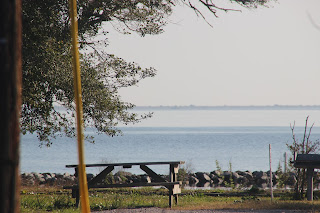Monday, January 4, 2016
We would like to give you a snapshot of
our work and living situation down here. It truly varies day to day.
We work and live on Harkers Island which is a community of 1800
people and the Park is at the end of this island. If you drive any
further, you would end up in Pamlico Sound. Our house is behind the
park visitor center. A large gate is locked every night but
fortunately we have a key so we can lock and unlock this huge steel
gate which extends across the road to block people from driving into
this area. We are the only people living out here now, but in the
summer there are RV pads across the road from the house for about 6
vehicles. So it is very quiet out here. We face the sound which is
about a 100 yards from our house.
This week we responded to letters from
children who sent their flat rangers. This is a project for
elementary age children to explore various parks and learn about
them. The children design a flat ranger with their name on the
ranger. Then as park staff we post this flat ranger in a variety of
settings (3) and describe what they would be doing as a ranger. In
this case the flat ranger would be leading a group of visitors on a
tour to see the lighthouse. One day we had to take 12 pictures for
three children and write a vignette for each picture and then forward
that request to another park requested by the student.
In addition we actually are involved in
some interpretive tours. On January 1st there was a
special New Years Day climb of the lighthouse. The trip was full; we
had 42 people who climbed all 207 steps to the top of the lighthouse.
Carol was perched at the landing which was at the 170 step which she
called BCL, Breath Catching Landing. We were charged with greeting
folks and helping to provide some interpretation. For example the
original lighthouse keepers needed to haul either whale oil or
kerosene up those 207 steps sometimes 2or 3 times a day to keep the
lens light burning. The 5 gallon jugs weighed about 50 lbs.
I was at the lightkeeper's house and
explained the history of the area and also about the German U-boats.
One major difference between lighthouses on the Great Lakes and those
on the Eastern Seaboard is that on the Great Lakes you were dropped
off in April or whenever the ice went out and not picked back up
until November. Cape Lookout ferry service made this site much more
accessible to the mainland and not so isolated.
As I stated earlier we knew information
about the Civil War and have learned more about the campaigns in
North Carolina but neither of us was aware of the German U-Boats
lurking off the coast of the Outer Banks during World War 2. We were
surprised to discover that they sank about 100 ships, a fact that the
wartime government did not make public. They didn't want to “alarm
citizens” so they did not tell them about their presence - hard to
imagine the government keeping secrets! A coast guard ship sank a
German U-boat about 10 miles from the lighthouse. They even captured
some German POWs. On Saturday we took the ferry over to Ocracoke
Island where there is a British Cemetery with specially noted grave
markers for four British seamen because FDR asked help from Britain
in the patroling of the waters off the Outer Banks.
To give a sense of our location - the
park is on the island but to get to the other sites, you need a boat.
Several staff members each have their own National Park Service boat
to get around. The wild horses are on Shackleford Island, the
lighthouse on Cape Lookout Island, Portsmouth Village is on another
island, as well as Great Island and Long Island. All have volunteer
housing in the summer. We are always on water either surrounded by it
on our lawns, roads, or traveling on it to get to work assignments.
We know the rhyme of the Ancient Mariner's line well: “Water,
water, everywhere and not a drop to drink; water, water everywhere
and all the boards did shrink!”
Here is Ms Carol and Steve our boss
heading out to Cape Lookout.





























